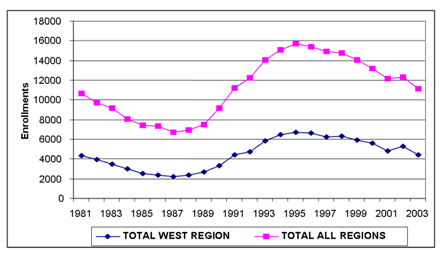Agency leaders cite an increasing disconnect
between society, particularly young people, and natural resources.
A decade of environmental controversy has left many students
uncertain about the future of natural resource careers. Where
will the professional workforce be found to carry out the
sustainable management of the nation’s forests? What
will be the future of natural resource science colleges if
low enrollment trends continue? Aggressive approaches to
college recruitments are clearly needed that better identify
student candidates, capture their attention, and assure potential
students with sufficient desire and aptitude that access
to higher education will be made available.
 |
| Figure 1. USDA Forest Service Employment vs. Age: 75%
of GS15, 64% of GS14, and 57% of GS13 are over 50 years
old. Source: John Kusano, Assistant Director
of Human Resources Management, USDA Forest Service. |
Reductions in the harvests of public forests over the last
two decades have resulted in dramatic changes to the economies
of Washington’s rural timber-dependent communities. In
2002, the Washington Employment Security Department reported
the widest urban-to-rural income disparity in 30 years. Many
of the state’s rural counties have unemployment rates
over 10%. In response to these economic shifts, State and Federal
programs, such as Running Start and Displaced Workforce Training,
have been created to provide tuition assistance packages for
rural residents to attend Washington State’s 34 Community
and Technical Colleges.


Rural students have always faced formidable obstacles
to their pursuit of higher education. Many students must deal
with such barriers as poor academic performance in high school,
limited English-language skills, and financial hardships. Others
are place- or situation-bound people with jobs, homes, and
family obligations. A growing percentage of rural students
are making mid-career adjustments. Community colleges are playing
a critical role in providing affordable local opportunities
for high quality education. Seventeen times as many undergraduate
students from rural timber-dependent communities are enrolled
in community colleges as compared to the University of Washington.
While enrollments with majors in natural resource sciences
have been declining at four-year colleges and universities,
surprisingly a number of community colleges are finding high
demand. The response has been creation and expansion of community
college resource science programs.
 |
| Figure 2. Undergraduate Enrollment in Natural Resources
for the West and the Nation. Source:
T.L. Sharik and K. Earley, Department of Environment and
Society, College
of Natural Resources, Utah State University. |
The Washington Board for Community and Technical
Colleges has shown that 65% of all undergraduates in the State
are enrolled in community and technical colleges. If more seamless
higher education partnerships could be established between
community colleges and university natural resource programs,
then increases in transfer enrollments should result. Individuals,
communities, colleges, universities, resource management organizations,
and the broader society would all benefit.
Opportunities for synergism have not gone unnoticed. Community
colleges are joining with public universities to develop “two
plus two” programs where community college curriculums
are designed for perfect fit such that transfer students bring
two full years of required credit and are assured swift completion
of a four-year degree. In some cases, courses will be taught
for university credit on community college campuses or through
distance learning offered over the internet. There is also
discussion that community colleges could possibly get accreditation
to offer limited bachelor’s degrees.
Stewardship of America’s forests for a future that insures
sustainable ecosystems and reliable flows of products will
require educated professionals capable of addressing complex
resource management challenges. Rural residents with historic
ties to the land and resource industries are likely candidates
if opportunities for higher education can be expanded. A strong
public commitment to innovative educational deliveries that
create greater flexibilities and broader access at less cost
will increase student enrollments in natural resource science
programs.
References:
- Renewable Natural Resources Foundation (2003-4). Federal
natural resource agencies confront an aging workforce
and challenges
to their future roles. Renewable Resources Journal. 2 (14).
www.rnrf.org

|











